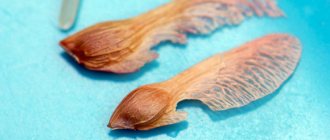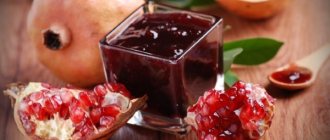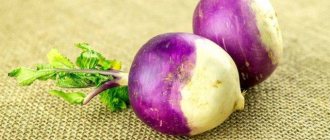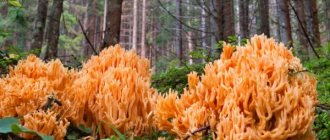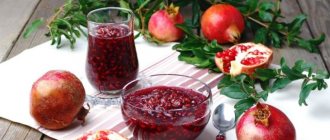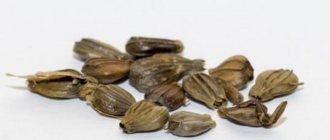Jugs
The flower of the “female” type has a more convex base and its appearance somewhat resembles a small jug. The edges of the “neck” of the jug are decorated with triangular dense teeth, which turn into a crown on an adult fruit. The pistils of the “female” flower are quite long and are located at or above the stamens.
Such inflorescences do not form on young shoots less than one year old. The ovary of the bud consists of several nests, which, when the fruit ripens, are filled with grains.
Growing fruit in a summer cottage
Fans of exotic plants know well how to plant pomegranate in their garden so that it bears fruit. The main condition for growing the royal fruit is fertile soil. In the selected area, dig a hole with a diameter and depth of 60 cm. Lay the top layer of soil on its bottom, place the seedling at an angle of 45 degrees, lightly compact it, bury it and water it abundantly. Thanks to this tilt, it will be easier to cover the plant for the winter with spruce branches, fabric or soil.
Under no circumstances should manure, mineral fertilizers or humus be added to the hole when planting a pomegranate. It is advisable to fertilize the soil 3 months before so that the plants successfully take root in the country garden.
The next day after planting, preferably in the evening, water again and cover the soil near the trunk with mulch of slightly rotted sawdust or leaves. Water young trees once a week. Fertilizing can be done in late spring or early June. Plow the soil around the seedling periodically to remove weeds.
To prepare the pomegranate for the winter, the bushes are covered with soil in November. But first they are tilted to the ground and tied to stable stakes. In such a “storage” the tree will calmly endure the cold winter frosts. And perhaps in a year the royal fruits from the dacha plot will appear on the table.
Bells
The buds of “male” inflorescences, unlike “female” ones, have a narrower part at the base and a wider part at the end. Thanks to this, their appearance resembles bells.
The pistils of these cute bells are short and hidden inside the anthers. Such inflorescences most often appear on fresh branches of the current year and, after they bloom, simply fall from the tree.
The ratio of the total number of “male” and “female” inflorescences most often depends on a particular variety. Additionally, this point can be influenced by proper care and environmental conditions.
Beneficial features
It is not easy to talk about all the beneficial properties of pomegranate. If only because every part of the fruit - juice, seeds, partitions, bark - contains substances that strengthen human health.
Take at least juice. It boasts high levels of antioxidants - significantly higher than blueberries, green tea or citrus fruits. The amino acids contained in it strengthen the heart muscle. Tannins, which the juice is also rich in, prevent sore throat, gum disease, and stop diarrhea. Finally, it contains a large amount of iron. Therefore, when the level of hemoglobin in the blood is low, many doctors prescribe their patients to add pomegranates to their diet.
White membranes have a positive effect on the nervous system, reducing nervous tension. And if you sprinkle crushed peel on the burn, this will significantly reduce the pain.
Color spectrum
The color palette of a plant such as pomegranate is varied only in scarlet, crimson, pink and white shades. There are varieties of variegated inflorescences.
The shape of the flower can be so unusual and elegant that at first glance it is impossible to understand what kind of plant it is.
Sprouting pomegranate from seeds
First of all, it’s worth understanding how pomegranate grows from a seed. Perhaps this is not the best option - when using a seedling, it is possible to reduce the waiting time before receiving the first harvest by three to four years. Alas, it is not always possible to find seedlings in regular stores. In addition, when grown from seed, you can get a stronger plant that is better acclimatized to the harsh climate of our country.
So what do you need to do to achieve this?
First of all, buy a beautiful, large fruit in the store. Please note - red fruits usually have a more sour taste, while yellowish ones can boast of sweetness. Unusual, but it's a fact.
The next step is to extract the seeds from the fruit. It is advisable to take them with a reserve, about 30-50 grains. And if you want to get not just one sprout, but several, you can have more. Alas, the germination rate of the seeds is not very high. Moreover, you need to take the grains with the shell, and not the bare seeds.
To begin with, they need to be placed in a warm, dry and dark place for about a week. During this time, the shell will become a little flabby. Now you need to put them in a paper envelope or wrap them in cloth and put them in the refrigerator (or better yet, in the freezer) for at least a week.
After this, you can safely plant the finished seeds in a pot with fertile soil (preferably light, maybe with a small admixture of sand) and good drainage - pomegranate does not like excess moisture. The planting depth is small - about 1 centimeter.
The pot is then covered with film on top to create a greenhouse effect. If the seeds turn out to be of high quality, then within a week or two the first shoots will appear on the surface.
Pomegranate flowering time
A plant grown from a seed usually blooms after 3-4 years, for a pomegranate grown from a cutting - 2-3 years. Sometimes pomegranates bloom abnormally early, usually in this case only a few buds bloom and subsequently fall off.
Pomegranate, when grown at home, has two flowering periods. The first flowering occurs in April-May, the second in August. Despite the fact that one bud fades in 3-4 days, it is immediately replaced by another bud, and this continues until the end of the entire period.
How to plant a pineapple from the top: care tips, maintenance rules and features of growing at home (135 photos + video)
What is the difference between strawberries and wild strawberries - 120 photos, videos and comparison of garden and forest species. Description of differences and detailed analysis of features
How to grow cherries from pits - tips on how to grow them easily and quickly at home. Features of care and maintenance of cherries (105 photos)
Until autumn, the plant shines with flowers like garlands. It is especially interesting to watch the formation of buds, flowering and fruit formation - at such moments the pomegranate looks very luxurious and fabulous.
How to grow pomegranate at home
A dwarf variety of pomegranate is grown indoors. These miniature trees rarely grow above one meter; their usual height is about 70 centimeters in mature plants. The leaves are small, and with good lighting in warm rooms they can be preserved all year round. At low temperatures or lack of light, leaves begin to fall off.
If an indoor pomegranate has completely shed its leaves for the winter, it is better to move it until spring to a cool room with a temperature of about +6°C (a frost-free basement or cellar with sufficient ventilation) and hardly water it until spring.
During a cold winter in a leafless state, indoor pomegranate wakes up in March - April. The leaves unfurl first, and about a month later the first flowers appear. Flowering lasts until September - October.
In summer, it is very useful to expose indoor pomegranates to the open air, in a bright place protected from the winds on the balcony or in the garden.
The fruits of indoor pomegranate do not exceed 2–3 centimeters in diameter. They are edible, but their taste is very mediocre, especially compared to the fruits of garden varieties. These fruits can remain on the branches for months, greatly decorating the pomegranate tree.
My neighbors in my old apartment had a beautiful specimen of an indoor pomegranate on their windowsill. It was a beautiful mature tree, almost a meter high, growing in a relatively small pot with a volume of about three liters. It stood on the windowsill of a large, bright window in a warm room and was decorated with flowers and fruits all year round. In autumn and winter, some of the leaves still fell off, but quite a lot of them remained on the branches, and the tree retained a very attractive appearance all winter.
Indoor pomegranate (video)
Pomegranate is a very beautiful plant and not too demanding to care for. In those regions where winter frosts do not allow growing pomegranate trees in the garden in open ground, there is always the opportunity to acquire a dwarf indoor pomegranate, which grows well in an ordinary flower pot on the windowsill.
- Author: werakulik
Rate this article:
- 5
- 4
- 3
- 2
- 1
(1 vote, average: 5 out of 5)
Share with your friends!
Natural flower drop
As we already understood, pomegranate buds falling off during flowering is a normal phenomenon. In this regard, the plant itself determines how many flowers it can withstand, so that in the future it does not become depleted. This is a natural process not only for the common pomegranate, which grows outdoors, but also for a similar indoor plant, for example, such as the dwarf pomegranate.
Whatever the variety, if the tree bears fruit, then the falling off of the inflorescences is inevitable. And let us remind you that it is mainly “male” specimens that fall off - barren flowers.
Tips if pomegranate does not bloom
If a tree cannot bloom for a long time, then it is recommended:
- feed it with complex organic fertilizer (to prepare it you will need 1 kg of cow manure, 15 g and 7.5 g of potassium fertilizers, dilute 12 g of superphosphate in 15 liters of water; water the tree every 2 weeks from March to mid-August);
- for indoor specimens, the correct soil should be prepared (mix turf soil, humus and bone meal; plaster or dried cow dung can be used as drainage).
To make the pomegranate bloom, you can use chemicals. But experienced gardeners advise using them only in extreme cases, when no other trees grow nearby. Before applying chemicals, you should carefully study the instructions for use and strictly follow them.
Diseases and pests
Heavier than natural flowering of pomegranate buds is usually a sign of plant disease.
The appearance of a white coating on pomegranate leaves is a sign of powdery mildew. Treatment can be carried out using Fundazol.
Peaches: benefits and harms for the health of the human body: expert advice, review of composition and recommendations for use (100 photos)
How persimmon grows: a detailed description of the fruit and video instructions for growing and caring for it at home + 125 photos
- When strawberries ripen: timing and approximate ripening dates. Useful information on collecting and growing berries (85 photos and videos)
For gray rot (this disease is dangerous not only due to the falling of flowers, but also due to the drying out of the shoots), the antimicrobial fungicide Topsin M is used.
With the death of the main branches, ringing of the base of the shoots, cracking of the bark and general weakening of the plant, a diagnosis of Phomosis damage to pomegranate can be made. With this disease, the “female” inflorescences become infertile. You can treat using the fungicide Horus.
In addition to general diseases, a plant such as pomegranate very often suffers from insects.
Whiteflies love to attack leaves; they greedily attack them and suck out the juice. The insecticide Derris works well to kill this insect.
The pomegranate codling moth eats the juicy pulp of ovaries, inflorescences and fruits. This parasite is combated using Intra-vir and Fitoverm.
How to grow a lemon from a seed at home - a detailed description of planting and care tips. Video instructions for growing + 100 photos
What a peach looks like - a description of the appearance, characteristics and properties of the fruit. Useful tips on choosing, growing and caring for peaches (110 photos)
What are the benefits of apricots - beneficial properties, composition, health benefits and contraindications for use. 75 photos of apricot
Varieties of pomegranate, their main characteristics and biological features
In the modern botanical classification, pomegranate belongs to the Derbennikov family; previously, it was often classified as a separate Pomegranate family.
There are very few types of pomegranate:
- wild Socotra pomegranate, growing only in Yemen on the island of Socotra and not used in any way in culture;
- the common pomegranate, widely distributed throughout the Mediterranean and Western Asia in gardens and in the wild, with many cultivated fruit and ornamental varieties;
- The dwarf pomegranate is a miniature variety of the common pomegranate and, due to its compact size, is very popular as a houseplant around the world.
Pomegranate is a small multi-stemmed tree or shrub up to 5 meters high. Very often its branches have sharp spines at the ends, especially in wild forms. The leaves are bright green, narrow, up to 8 centimeters long and up to 2 centimeters wide. In the tropics, pomegranate behaves like an evergreen plant; in the subtropical zone with relatively cold winters, its leaves fall off in the fall. In indoor cultivation, pomegranate leaves can be preserved all year round or fall off completely or partially for the winter, it depends on the lighting and temperature in the room.
Pomegranate is an important fruit crop in warm climates.
The first flowers and fruits begin to appear on plants at the age of three. Flowering is very long, in open ground it begins in spring and lasts almost all summer, and individual single flowers can appear even in early autumn.
With good care, many indoor varieties of pomegranate can bloom almost all year round.
Pomegranate flowers come in two types:
- bell-shaped without an ovary, which does not bear fruit and falls off soon after flowering;
- pitcher-shaped with a clearly visible ovary of the future fruit; it is from these flowers that the fruit crop is formed after pollination.
Pomegranate fruits grow from flowers with a clearly visible ovary
The wild pomegranate and most of its fruit varieties have bright red flowers. The flowers of its decorative varieties are red, white or variegated white and red. In wild plants and fruit varieties the flowers are simple, in decorative forms they are simple or double.
As a rule, double pomegranate flowers do not produce fruit.
Pomegranate is a self-pollinating plant. It takes about 4–5 months from flowering to fruit ripening; normal ripening requires high air temperatures of at least +25°C.
Pomegranate fruits ripen for several months
The pomegranate fruit is completely unique in its structure and in scientific botanical terminology it is called “pomegranate”. These fruits are spherical in shape with a crown-like corolla on the side opposite the stalk. Beneath the rough and inedible brownish-red or dark red skin are numerous edible pomegranate “grains”—its seeds, each of which is surrounded by a layer of delicious, juicy pulp. These “grains” are most often dark red, but in some varieties they are light red or pink. The fruits of cultivated forms of pomegranate taste sour, sweet and sour-sweet. They ripen very late, depending on the variety and region, from September to November. Ripe fruits very often crack directly on the tree, especially with a lack of moisture.
Pomegranate fruits often crack directly on the tree
The average weight of pomegranate fruits in cultivated forms is about 200–250 grams, and in the best large-fruited varieties the fruits reach a weight of 500–800 grams and a diameter of 15–18 centimeters. In industrial cultivation, the yield reaches 30–60 kilograms of fruit from one tree or bush. Pomegranate is very durable and, in good conditions, bears fruit for up to 100 years or more. Collected ripe fruits can be stored for up to several months at low temperatures above zero in a dry room with good ventilation.
Improper care
In addition to diseases and pests, pomegranate flowering often suffers from improper care.
Illiterate watering. This plant does not always need normal watering. Very often, during the flowering period, gardeners do not water it enough. But if you don’t delve into the essence of the matter, you can simply destroy the plant, which will not only begin a massive decline in flowers. The leaves will begin to fade and the tree will wither.
Spring frosts are also dangerous both for the tree and for future inflorescences. If a pomegranate survives such a nuisance, its flowering will either be postponed until next year, or it will be late and not abundant.
Insufficient lighting. Of course, the tree will grow in the shade, but without flowering, since it needs an eight-hour period of sunlight per day.
Incorrect tree pruning. The formation of the pomegranate crown must be done in late February - early March, when the plant has not yet fully awakened and there are no green shoots.
If you do this later and start cutting off green shoots with buds, the plant will only suffer and will take a very long time to recover! During the active growth period of the plant, only the shoots in the lower part of the trunk are cut off.
Insufficient air humidity. When the air is dry, the tree begins to wither. To increase moisture in the air, you can use spraying or place the container with the plant on a tray with wet expanded clay.
Why doesn't pomegranate bloom?
The main reasons that pomegranate does not bloom are:
- suitable climate (too cold weather, excess or lack of moisture, lack of light);
- improper care, improper watering, insufficient or excessive fertilization);
- pests and diseases (whitefly, powdery mildew, fomos, gray rot).
Photo of pomegranate flowering
History of distribution and homeland of pomegranate
The pomegranate is considered one of the most ancient plants; many scientists put it on a par with grapes, olive trees and figs, i.e. with those crops that played a huge role in the history of the development of the peoples of the world. Mentions of this plant have been found in various sources for at least the last 4 thousand years; there is information about it in documents of Ancient Greece and Ancient Rome, where it is called the Carthaginian or granular apple.
Important! Some historians believe that the pomegranate was the apple that the Serpent-Tempter presented to Eve.
In ancient times, pomegranate was considered a royal fruit because of its unique “crown.”
It is believed that the birthplace of pomegranate is Persia (the territory of modern Iran). From there, this plant came to Transcaucasia, the lands of Asia Minor and North Africa. Later it spread throughout all Mediterranean countries, and was brought to Southern Europe and Central Asia. With the development of navigation, the pomegranate also appeared in the Western Hemisphere, in America, on the islands of the Caribbean and the Pacific Ocean.
Important! The development of industrial production of pomegranate was given a lot of attention in the Soviet Union; thanks to this policy, large plantations of these trees appeared in Uzbekistan and Turkmenistan.

